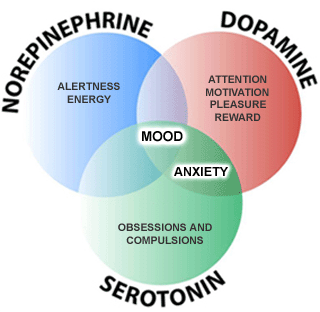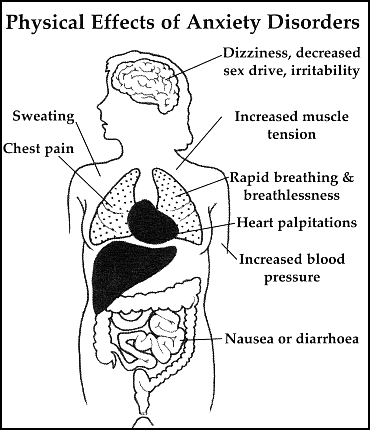– Happy Messengers, Sad Messengers
Neurotransmitters or brain chemicals pass messages from one part of the brain to the next. Some messages are communicated around the brain by ‘sad messengers’. These ‘sad messengers’ or neurotransmitters tell the brain to be downhearted, cautious, and dispirited. An excess of sad messengers make us depressed, anxious, sleepless and fatigued. They dominate when we feel overwhelmed by life’s demands. The ‘sad messengers’ are cortisol and a group of enzymes that rob us of ‘happy messengers’. This is a natural physical response to anxiety.
However some of these messages are upbeat and keep us happy, able to cope with pain and to remain tranquil. Happy messengers are serotonin, noradrenaline and dopamine, as well as a group of natural tranquilizers.

What determines our mood?
The balance between the happy and sad messengers determines out mood. As long as they are in balance we are tranquil and happy. If something happens to upset the balance and the sad messengers dominate, our happiness gives way to misery and emotional pain. Tranquility, which is the natural state of the human brain, gives way to anxiety.
What upsets the balance?
- Illness can, as your body is in battle and sad messengers are vital for fighting disease. Often even with flu, you will feel slightly depressed. The reason is that your body needs to slow down and even disengage from normal activities so it can reserve its strength to fight the invading bacteria or viruses. Cooperate with them, take time out and you will recover sooner.
- Caffeine, nicotine, alcohol, recreational drugs and even some prescription drugs can upset the balance between happy and sad messengers and are to be avoided.
- Stress is the most important factor that influences the balance levels. When the brain senses stress, it assumes that there is an emergency and gets into the fight or flight response. Our sad messengers kick in and take control of for survival. The sad messengers are like fighter pilots who train all their lives for battle, and relish the moment they are finally called into action. As the level of stress escalates, the upper hand goes to the sad messengers and the mood changes from tranquil and happy to anxious and unhappy. The brain is in a state of chemical unbalance.
Restoring the Balance of the Messengers
Medication Take some anti- anxiety medication to restore the balance of messengers. The brain is sick. Ignoring the problem can make the situation worse and lead to agoraphobia. Agoraphobia is the fear of public places with a fear that you can’t get back to your place of safety. The brain has natural tranquilizers and tranquilizer medication mimics what the brain is already doing for itself. Tranquilizers work because the brain is designed for them to work. Tranquilizers can be addictive and must be carefully monitored by the doctor. Don’t go off suddenly because you feel better.
Withdrawal symptoms rarely occur if the medication is tapered off very slowly. Withdrawal may include rebound anxiety (anxiety returns but much intensified), agitation, diarrhea insomnia, headaches, ringing in the ears, low blood pressure, and blurred vision. Suddenly stopping Xanax can precipitate severe panic attacks. Here it is advisable to shave off a few granules at a time when you’re weaning yourself off the drug. It is a slow process, but the body will be ‘tricked’ into not noticing the dosage going down!
Sort out stress levels. :A bit of stress keeps us going but prolonged stress is like stepping in front of a fast-moving train.
Change the way you think – This is commonly known as cognitive therapy and involves changing the way you think. This combined with medication is recognized as the most successful treatment for anxiety and depression.
SYMPTOMS PRECEDING A PANIC ATTACK
Learn these so you can learn to abort a panic attack developing.
- Increased sensitivity to light
- Tunnel or diminished vision
- Tight throat
- Indigestion
- Burning sensation in the stomach
- Acute hearing and intolerance to noise
- Missed heartbeats
- Nausea
- Lightheadedness and dizziness
- Pins & needles or localized burning sensations
- Cold flushes
- Hyperventilation.

FIRST AID TO STOP A PANIC ATTACK
If you can recognize the start of hyperventilation you can stop your panic attack. When anxiety triggers hyperventilation, the normal respiratory process goes wrong.
The cycle of events goes something like this:
- Something in your life, or just your thoughts, causes you to feel anxious.
- This raised anxiety speeds up your respiration because your body thinks there is an emergency.
- You begin to take in more oxygen than your body needs, and your carbon dioxide drops. Without enough carbon dioxide, your blood cannot carry waste products away so a state of extreme emergency is created.
- If you are panic prone, this state of emergency will trigger a panic attack. Cup hands over mouth, or use paper bag.
What next?
You need to get fewer breaths coming in, and more going out in order to reduce the amount of oxygen entering your body.
- Immediately you recognize what is happening, take short breaths through you nose and have a long out-breath through your nose.
- Or cup your hands over your mouth and nose while breathing. This will reduce the oxygen intake.
- Breathe into a paper bag.
Some people even have panic attacks while they’re resting. Some happen while sleeping and wake up the sufferer and 61% happen while a person is going to sleep.
Why does it happen when I’m going to sleep?
Stress symptoms don’t always appear at the height of stressful situation. For example a tension headache strikes after the project is over. During an emergency, adrenaline protects us from pain or stress discomfort. Only after adrenaline has done its job does it demand its penalty!
And finally…
Don’t blame others for your stress. We create our own unhappiness; we can create our own joy!